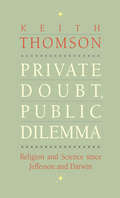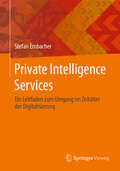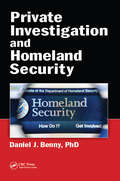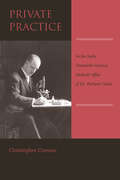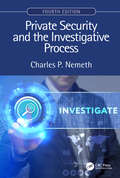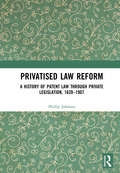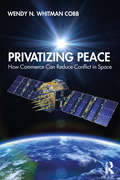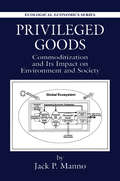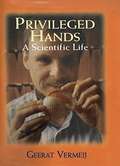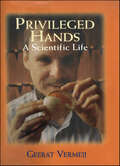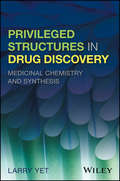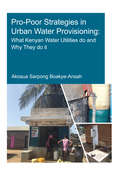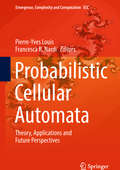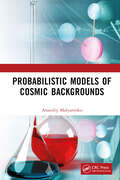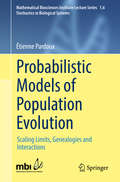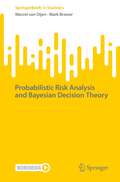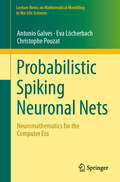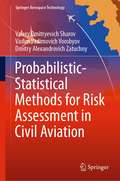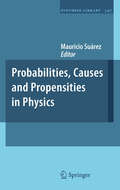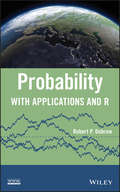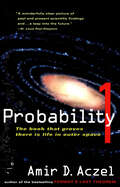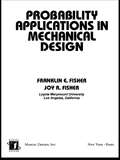- Table View
- List View
Private Doubt, Public Dilemma
by Keith Stewart ThomsonEach age has its own crisis--our modern experience of science-religion conflict is not so very different from that experienced by our forebears, Keith Thomson proposes in this thoughtful book. He considers the ideas and writings of Thomas Jefferson and Charles Darwin, two men who struggled mightily to reconcile their religion and their science, then looks to more recent times when scientific challenges to religion (evolutionary theory, for example) have given rise to powerful political responses from religious believers. Today as in the eighteenth century, there are pressing reasons for members on each side of the religion-science debates to find common ground, Thomson contends. No precedent exists for shaping a response to issues like cloning or stem cell research, unheard of fifty years ago, and thus the opportunity arises for all sides to cooperate in creating a new ethics for the common good.
Private Intelligence Services: Ein Leitfaden zum Umgang im Zeitalter der Digitalisierung
by Stefan EmbacherDie Einführung des Buches legt den Grundstein für die nachfolgenden Kapitel, indem sie die Definitionen und Grundlagen der Wirtschaftskriminalität klärt und ein solides Verständnis für die Dimensionen und die Tragweite dieser Herausforderung schafft. Sie legt dar, wie Wirtschaftskriminalität nicht nur finanzielle Verluste verursacht, sondern auch das Vertrauen in Märkte und Institutionen untergräbt, was weitreichende soziale und wirtschaftliche Konsequenzen nach sich zieht. Im ersten Kapitel wird die Zusammenarbeit zwischen privaten Intelligence-Unternehmen und staatlichen Behörden beleuchtet. Es werden Fallstudien und Beispiele präsentiert, die demonstrieren, wie eine erfolgreiche Partnerschaft aussehen kann, und welche Herausforderungen und Spannungsfelder dabei auftreten können. Das Kapitel unterstreicht die Bedeutung von Vertrauen, Transparenz und gegenseitigem Respekt für den Erfolg dieser Kooperationen. Das zweite Kapitel widmet sich den spezifischen Herausforderungen und Anforderungen, die verschiedene Branchen und Sektoren an private Intelligence-Unternehmen stellen. Es wird detailliert aufgezeigt, wie unterschiedlich die Bedürfnisse von Unternehmen, je nach Größe, Branche und geografischer Lage sein können, und wie maßgeschneiderte Lösungen aussehen können. Es wird deutlich, dass eine tiefgehende Branchenkenntnis und Spezialisierung essentiell sind, um effektive Dienstleistungen zu bieten. Das dritte Kapitel ist in mehrere Unterkapitel gegliedert und deckt ein breites Spektrum an Themen ab, darunter die besonderen Anforderungen bestimmter Zielgruppen, Methoden und Techniken zur Sicherung von Vermögenswerten und Informationen, sowie praxisnahe Fallbeispiele und Best Practices. Hier wird auch aufgezeigt, wie Unternehmen wie Foreus als Dienstleister in der Praxis agieren und welche Rolle sie im Gesamtkontext spielen. Das vierte Kapitel setzt sich mit den rechtlichen und ethischen Aspekten von Private Intelligence auseinander. Es werden aktuelle Gesetzgebungen und Rechtsprechungen diskutiert, ethische Dilemmata beleuchtet und klare Empfehlungen und Richtlinien für verantwortungsvolles Handeln präsentiert. Das fünfte Kapitel blickt in die Zukunft und versucht eine Prognose über die nächsten 10 Jahre im Bereich Private Intelligence und Wirtschaftskriminalität abzugeben. Es werden technologische Entwicklungen, Ausbildungs- und Weiterbildungsmöglichkeiten sowie potentielle Herausforderungen und Chancen diskutiert. Das abschließende sechste Kapitel fasst die zentralen Erkenntnisse zusammen, bietet konkrete Handlungsempfehlungen für verschiedene Fachleute und endet mit abschließenden Gedanken und einem Ausblick in die Zukunft.
Private Investigation and Homeland Security
by Daniel J. BennyThe threat against the homeland continues and the private investigator plays a critical part in this effort. This includes in providing criminal, civil and background investigation, protective service, security consulting and electronic sweeps. The text will provide an overview of the role of private investigation in protection of the homeland and show how such skill can be utilized by business and government in this effort.
Private Madhouses in England, 1640–1815: Commercialised Care for the Insane (Mental Health in Historical Perspective)
by Leonard SmithThis book examines the origins and early development of private mental health-care in England, showing that the current spectacle of commercially-based participation in key elements of service provision is no new phenomenon. In 1815, about seventy per cent of people institutionalised because of insanity were being kept in private ‘madhouses’. The opening four chapters detail the emergence of these madhouses and demonstrate their increasing presence in London and across the country during the long eighteenth century. Subsequent chapters deal with specific aspects in greater depth - the insane patients themselves, their characteristics, and the circumstances surrounding admissions; the madhouse proprietors, their business activities, personal attributes and professional qualifications or lack of them; changing treatment practices and the principles that informed them. Finally, the book explores conditions within the madhouses, which ranged from the relatively enlightened to the seriously defective, and reveals the experiences, concerns and protests of their many critics.
Private Practice: In the Early Twentieth-Century Medical Office of Dr. Richard Cabot
by Christopher CrennerThe beginning of the twentieth century marked the rise of advanced medical technologies, allowing doctors to diagnose and treat diseases in new ways. Although American physicians accepted the validity of the new science of medicine, they were sometimes reluctant to trust technology over their professional judgment or intuition. Likewise, patients raised their own suspicions about the new scientific tools, sometimes resisting or contradicting the advice of their physicians.Here Christopher Crenner examines a critical period in medical history, focusing on the office practice of Boston physician Richard Cabot. Intimate epistolary exchanges between Cabot and his patients shed light on the challenges presented by the new technologies—especially their impact on the personal relationships between doctor and patient—providing insight into a time of expanding science and radical change.
Private Security and the Investigative Process, Fourth Edition
by Charles P. NemethPrivate Security and the Investigative Process, Fourth Edition is fully updated and continues to provide complete coverage of the investigative process for private investigations by both individuals and in corporate security environments. This edition covers emerging technology, revised legal and practical considerations for conducting interviews, and new information on case evaluation. Written by a recognized expert in security, criminal justice, ethics, and the law—with over three decades of experience—the updated edition of this popular text covers concepts and techniques that can be applied to a variety of investigations including fraud, insurance, private, and criminal. It details the collection and preservation of evidence, the handling of witnesses, surveillance techniques, background investigations, and report writing. The book reflects best practices and includes tips for ensuring accurate and reliable private sector security investigations. This new edition includes: A new section on career opportunities in paths in the investigative field A rundown of the leading security Industry associations and professional standards being published Added discussion of observational interviews include current protocols analyzing data Details of the current legal implications for security surveillance and practices Advances in technology to thwart crime and fraud in retail and other business settings An entirely new section on e-records from criminal and civil judgments Authoritative, yet accessible, this book is one of the only textbooks dedicated to the subject. It also serves as an important reference for private investigators and security professionals. Complete with numerous forms, checklists, and web exercises, it provides the tools and understanding required to conduct investigations that are professional, ethical, and effective.
Private or Socialistic Forestry?: Forest Transition in Finland vs. Deforestation in the Tropics
by Matti Palo Erkki LehtoWhile deforestation continues at an alarming rate around the world, discussions on the range of underlying causes continue. The premise is that studying successful transitions from deforestation to sustainable forestry ex post in Finland can provide novel insights into how deforestation in the tropics might be reduced in the future. Our fundamental question here is why Finland succeeded to stop deforestation for a century ago and why not the same is feasible in the contemporary tropical countries? This book presents a novel integrated theory within which this case study on Finland and contemporary modeling of underlying causes of tropical deforestation are developed. Finland remains the world's second largest net exporter of forest products, while maintaining the highest forest cover in Europe. A transition from deforestation to sustainable industrial forestry took place in Finland during the first part of the 20th century. The underlying causes of this transition are compared via our theory with deforestation in 74 contemporary tropical countries. Both appear similar and support our theory. The interaction of public policies and market institutions has appeared to be critical during this transition. The study's findings suggest that private forest ownership with a continuous increase in the real value of forests and alleviation of poverty under non-corruptive conditions has been a necessary, but not a sufficient, condition for this transition. In a parallel way public policies have also proved to be a necessary, but not sufficient, condition in this transition. The conclusion is that socialistic forestry along with corruption is artificially maintaining too low values in the tropical forests. The opportunity cost of sustainable forestry remains too high and deforestation by extensification of agriculture therefore continues. The prevailing socialistic forestry with dominating public forest ownership is by purpose maintaining administratively set low stumpage prices leading to low value of forests, wide corruption and continuous forest degradation and deforestation. An effective remedy - to raise the value of forests - is found to be within forestry.
Privatised Law Reform: A History Of Patent Law Through Private Legislation, 1620-1907
by Phillip JohnsonIn the history of British patent law, the role of Parliament is often side-lined. This is largely due to the raft of failed or timid attempts at patent law reform. Yet there was another way of seeking change. By the end of the nineteenth century, private legislation had become a mechanism or testing ground for more general law reforms. The evolution of the law had essentially been privatised and was handled in the committee rooms in Westminster. This is known in relation to many great industrial movements such as the creating of railways, canals and roads, or political movements such as the powers and duties of local authorities, but it has thus far been largely ignored in the development of patent law. This book addresses this shortfall and examines how private legislation played an important role in the birth of modern patent law.
Privatizing Peace: How Commerce Can Reduce Conflict in Space
by Wendy N. Whitman CobbThis book explores the privatization of space and its global impact on the future of commerce, peace and conflict. As space becomes more congested, contested, and competitive in the government and the private arenas, the talk around space research moves past NASA’s monopoly on academic and cultural imaginations to discuss how Elon Musk’s SpaceX and Jeff Bezos’ Blue Origin is making space "cool" again. This volume addresses the new rhetoric of space race and weaponization, with a focus on how the costs of potential conflict in space would discourage open conflict and enable global cooperation. It highlights the increasing dependence of the global economy on space research, its democratization, plunging costs of access, and growing economic potential of space-based assets. Thoughtful, nuanced, well-documented, this book is a must read for scholars and researchers of science and technology studies, space studies, political studies, sociology, environmental studies, and political economy. It will also be of much interest to policymakers, bureaucrats, think tanks, as well as the interested general reader looking for fresh perspectives on the future of space.
Privileged Goods: Commoditization and Its Impact on Environment and Society
by Jack P. MannoWhat are the obstacles in the way of effectively solving the environmental crises of our time? What can we do to overcome them? These may be two of the most important questions heading into the 21st century. Organized human societies have the ability to completely change the world. While we have excelled at building, destroying and rebuilding, we h
Privileged Hands: A Scientific Life
by Geerat VermeijHis fingers move across the surface of a shell, feeling the ridges and contours, searching for clues, gathering information unnoticed by the untrained eye. For Dr. Geerat Vermeij's fingers are his eyes. One of the most accomplished evolutionary biologists of our time and the world's leading authority on an ancient "arms race" among mollusks, Dr. Vermeij is blind.No ordinary autobiography, Privileged Hands is the story of Dr. Vermeij's challenge and triumph. What makes his story so compelling is how he sees and what his insights reveal about the wonder of life on planet Earth. His exhaustive research of ancient and living mollusks, particularly shells, is extraordinary in its scope and perspective about how species arm themselves, compete, and survive. This is an intriguing irony for someone whose incomparable story is characterized by an unfailing determination to thrive in a sighted world and in the world of science. For Dr. Vermeij's self-portrait is also a portrait of the practice of science--his views on evolution and biodiversity, and the importance of observation are as much the story as are his family relationships, education, and position on arritmative action.Privileged Hands is provocative and intelligent storytelling: it reveals as much about our own lives as it does about this one, remarkable, scientist's life." 'Uplifting' may smack of sentimentality, but Vermeij's life story surely is uplifting—and it contributes importantly to evolutionary science." - Kirkus Reviews
Privileged Structures in Drug Discovery: Medicinal Chemistry and Synthesis
by Larry YetA comprehensive guide to privileged structures and their application in the discovery of new drugs The use of privileged structures is a viable strategy in the discovery of new medicines at the lead optimization stages of the drug discovery process. Privileged Structures in Drug Discovery offers a comprehensive text that reviews privileged structures from the point of view of medicinal chemistry and contains the synthetic routes to these structures. In this text, the author—a noted expert in the field—includes an historical perspective on the topic, presents a practical compendium to privileged structures, and offers an informed perspective on the future direction for the field. The book describes the up-to-date and state-of-the-art methods of organic synthesis that describe the use of privileged structures that are of most interest. Chapters included information on benzodiazepines, 1,4-dihydropyridines, biaryls, 4-(hetero)arylpiperidines, spiropiperidines, 2-aminopyrimidines, 2-aminothiazoles, 2-(hetero)arylindoles, tetrahydroisoquinolines, 2,2-dimethylbenzopyrans, hydroxamates, and bicyclic pyridines containing ring-junction nitrogen as privileged scaffolds in medicinal chemistry. Numerous, illustrative case studies document the current use of the privileged structures in the discovery of drugs. This important volume: Describes the drug compounds that have successfully made it to the marketplace and the chemistry associated with them Offers the experience from an author who has worked in many therapeutic areas of medicinal chemistry Details many of the recent developments in organic chemistry that prepare target molecules Includes a wealth of medicinal chemistry case studies that clearly illustrate the use of privileged structures Designed for use by industrial medicinal chemists and process chemists, academic organic and medicinal chemists, as well as chemistry students and faculty, Privileged Structures in Drug Discovery offers a current guide to organic synthesis methods to access the privileged structures of interest, and contains medicinal chemistry case studies that document their application.
Pro Evo
by Tomotom StiftungThe author (1911-2001) studied first agriculture and then economics. He had a successful career as a business man and business consultant. In search of the origin and meaning of existence, he discovered of it. in the 1950's a new, simple and reliable guideline for human thought and action. This guideline is oriented on cosmic evolution. Scientists have termed it the "evolutionary ethic". The author, beginning in 1971, published books about his discovery under his own name and pseudonyms. The titles included Lebensrichtig, Age of Joy, On the Side of Life, Zeitalter der Freude and Pro-Evo. The editions now available are Pro-Evo in German and this English translation
Pro-Poor Strategies in Urban Water Provisioning: What Kenyan Water Utilities Do and Why They Do It (IHE Delft PhD Thesis Series)
by Akosua Sarpong Boakye-AnsahWater utilities are the main instrument for countries to achieve universal service coverage. In pursuing universal service coverage, water utilities have turned to pro-poor water services to extend water services in low-income areas. This thesis discusses the use of pro-poor water services by water utilities in Kenya, with the intention of highlighting the dimensions of the approach that require attention of policy makers and practitioners when engaging with the concept. Based on the analysis of the technologies, financial and organisational arrangements associated with the pro-poor concept, this thesis shows that the use of pro-poor strategies allows water utilities to reduce the risks of servicing low-income areas while still claiming to fulfil their mandate of providing access to all in a commercially viable manner. The analysis also shows that rather than a decision of the water utility, the choice for pro-poor strategies emerges as the result of a consensus or compromise between the different actors that constitute the broader institutional environment in which water utilities operate. The thesis concludes that while pro-poor water services may serve the interests of water utilities and other stakeholders, in the absence of well-directed subsidies and proper monitoring they will not result in low-income households benefiting from more affordable and reliable access to water.
Probabilistic Cellular Automata: Theory, Applications And Future Perspectives (Emergence, Complexity And Computation Ser. #27)
by Pierre-Yves Louis Francesca R. NardiThis book explores Probabilistic Cellular Automata (PCA) from the perspectives of statistical mechanics, probability theory, computational biology and computer science. PCA are extensions of the well-known Cellular Automata models of complex systems, characterized by random updating rules. Thanks to their probabilistic component, PCA offer flexible computing tools for complex numerical constructions, and realistic simulation tools for phenomena driven by interactions among a large number of neighboring structures. PCA are currently being used in various fields, ranging from pure probability to the social sciences and including a wealth of scientific and technological applications. This situation has produced a highly diversified pool of theoreticians, developers and practitioners whose interaction is highly desirable but can be hampered by differences in jargon and focus. This book – just as the workshop on which it is based – is an attempt to overcome these difference and foster interest among newcomers and interaction between practitioners from different fields. It is not intended as a treatise, but rather as a gentle introduction to the role and relevance of PCA technology, illustrated with a number of applications in probability, statistical mechanics, computer science, the natural sciences and dynamical systems. As such, it will be of interest to students and non-specialists looking to enter the field and to explore its challenges and open issues.
Probabilistic Models of Cosmic Backgrounds
by Anatoliy MalyarenkoCombining research methods from various areas of mathematics and physics, Probabilistic Models of Cosmic Backgrounds describes the isotropic random sections of certain fiber bundles and their applications to creating rigorous mathematical models of both discovered and hypothetical cosmic backgrounds.Previously scattered and hard-to-find mathematical and physical theories have been assembled from numerous textbooks, monographs, and research papers, and explained from different or even unexpected points of view. This consists of both classical and newly discovered results necessary for understanding a sophisticated problem of modelling cosmic backgrounds.The book contains a comprehensive description of mathematical and physical aspects of cosmic backgrounds with a clear focus on examples and explicit calculations. Its reader will bridge the gap of misunderstanding between the specialists in various theoretical and applied areas who speak different scientific languages.The audience of the book consists of scholars, students, and professional researchers. A scholar will find basic material for starting their own research. A student will use the book as supplementary material for various courses and modules. A professional mathematician will find a description of several physical phenomena at the rigorous mathematical level. A professional physicist will discover mathematical foundations for well-known physical theories.
Probabilistic Models of Population Evolution
by Étienne PardouxThis expository book presents the mathematical description of evolutionary models of populations subject to interactions (e. g. competition) within the population. The author includes both models of finite populations, and limiting models as the size of the population tends to infinity. The size of the population is described as a random function of time and of the initial population (the ancestors at time 0). The genealogical tree of such a population is given. Most models imply that the population is bound to go extinct in finite time. It is explained when the interaction is strong enough so that the extinction time remains finite, when the ancestral population at time 0 goes to infinity. The material could be used for teaching stochastic processes, together with their applications. Étienne Pardoux is Professor at Aix-Marseille University, working in the field of Stochastic Analysis, stochastic partial differential equations, and probabilistic models in evolutionary biology and population genetics. He obtained his PhD in 1975 at University of Paris-Sud.
Probabilistic Risk Analysis and Bayesian Decision Theory (SpringerBriefs in Statistics)
by Mark Brewer Marcel van OijenThe book shows how risk, defined as the statistical expectation of loss, can be formally decomposed as the product of two terms: hazard probability and system vulnerability. This requires a specific definition of vulnerability that replaces the many fuzzy definitions abounding in the literature. The approach is expanded to more complex risk analysis with three components rather than two, and with various definitions of hazard. Equations are derived to quantify the uncertainty of each risk component and show how the approach relates to Bayesian decision theory. Intended for statisticians, environmental scientists and risk analysts interested in the theory and application of risk analysis, this book provides precise definitions, new theory, and many examples with full computer code. The approach is based on straightforward use of probability theory which brings rigour and clarity. Only a moderate knowledge and understanding of probability theory is expected from the reader.
Probabilistic Spiking Neuronal Nets: Neuromathematics for the Computer Era (Lecture Notes on Mathematical Modelling in the Life Sciences)
by Antonio Galves Eva Löcherbach Christophe PouzatThis book provides a self-contained introduction to a new class of stochastic models for systems of spiking neurons. These systems have a large number of interacting components, each one evolving as a stochastic process with a memory of variable length. Several mathematical tools are put to use, such as Markov chains, stochastic chains having memory of variable length, point processes having stochastic intensity, Hawkes processes, random graphs, mean field limits, perfect sampling algorithms, the Context algorithm, and statistical model selection.The book’s focus on mathematically tractable objects distinguishes it from other texts on theoretical neuroscience. The biological complexity of neurons is not ignored, but reduced to some of its main features, such as the intrinsic randomness of neuronal dynamics. This reduction in complexity aims at explaining and reproducing statistical regularities and collective phenomena that are observed in experimental data, an approach that leads to mathematically rigorous results. With an emphasis on a constructive and algorithmic point of view, this book is directed towards mathematicians interested in learning about stochastic network models and their neurobiological underpinning, and neuroscientists interested in learning how to build and prove results with mathematical models that relate to actual experimental settings.
Probabilistic-Statistical Methods for Risk Assessment in Civil Aviation (Springer Aerospace Technology)
by Dmitry Alexandrovich Zatuchny Valery Dmitryevich Sharov Vadim Vadimovich VorobyovThis book analyses the models for major risks related to flight safety in the aviation sector and presents risk estimation methods through examples of several known aviation enterprises. The book provides a comprehensive content for professionals engaged in the development of flight safety regulatory framework as well as in the design and operation of ground-based or on-board flight support radio electronic systems. The book is also useful for senior students and postgraduates in aviation specialties, especially those related to air traffic management.
Probabilities, Causes and Propensities in Physics
by Mauricio SuárezThis volume defends a novel approach to the philosophy of physics: it is the first book devoted to a comparative study of probability, causality, and propensity, and their various interrelations, within the context of contemporary physics -- particularly quantum and statistical physics. The philosophical debates and distinctions are firmly grounded upon examples from actual physics, thus exemplifying a robustly empiricist approach. The essays, by both prominent scholars in the field and promising young researchers, constitute a pioneer effort in bringing out the connections between probabilistic, causal and dispositional aspects of the quantum domain. The book will appeal to specialists in philosophy and foundations of physics, philosophy of science in general, metaphysics, ontology of physics theories, and philosophy of probability.
Probability
by Robert P. DobrowAn introduction to probability at the undergraduate levelChance and randomness are encountered on a daily basis. Authored by a highly qualified professor in the field, Probability: With Applications and R delves into the theories and applications essential to obtaining a thorough understanding of probability.With real-life examples and thoughtful exercises from fields as diverse as biology, computer science, cryptology, ecology, public health, and sports, the book is accessible for a variety of readers. The book's emphasis on simulation through the use of the popular R software language clarifies and illustrates key computational and theoretical results.Probability: With Applications and R helps readers develop problem-solving skills and delivers an appropriate mix of theory and application. The book includes:Chapters covering first principles, conditional probability, independent trials, random variables, discrete distributions, continuous probability, continuous distributions, conditional distribution, and limitsAn early introduction to random variables and Monte Carlo simulation and an emphasis on conditional probability, conditioning, and developing probabilistic intuitionAn R tutorial with example script filesMany classic and historical problems of probability as well as nontraditional material, such as Benford's law, power-law distributions, and Bayesian statisticsA topics section with suitable material for projects and explorations, such as random walk on graphs, Markov chains, and Markov chain Monte CarloChapter-by-chapter summaries and hundreds of practical exercisesProbability: With Applications and R is an ideal text for a beginning course in probability at the undergraduate level.
Probability 1
by D. AczelFor thousands of years, it was the visionaries and writers who argued that we cannot be alone-that there is intellegent life in the universe. Now, with the discoveries of the Hubble Telescope, data emerging from Mars, and knowledge about life at the extremes, scientists are taking up where they left off. Amir Aczel, author of Fermat's Last Theorem, pulls together everyting science has discovered, and mixes in proabability theory, to argure the case for the existence of intelligent life beyond this planet. Probability 1 is an extraordinary tour de force in which the author draws on cosmology, math, and biology to tell the rollicking good story of scientists tackling important scientific questions that help answer this fundamental question. What is the probability of intelligent life in the universe? Read this book, and you'll be convinced, by the power of the argument and the excitement of the science.
Probability Applications in Mechanical Design (Mechanical Engineering)
by Franklin E. Fisher Joy R. FisherThe authors of this text seek to clarify mechanical fatigue and design problems by applying probability and computer analysis, and further extending the uses of probability to determine mechanical reliability and achieve optimization. The work solves examples using commercially available software. It is formatted with examples and problems for use
